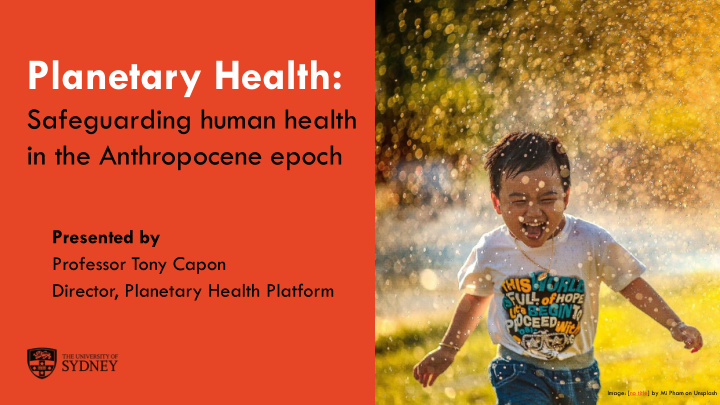



Planetary Health: Safeguarding human health in the Anthropocene epoch Presented by Professor Tony Capon Director, Planetary Health Platform The University of Sydney Page 1 Image: [no title] by Mi Pham on Unsplash
This talk 1. The Anthropocene epoch 2. The Rockefeller Foundation – Lancet Commission on Planetary Health 3. What does this mean for environmental health and the work of environmental health officers?
The Anthropocene epoch https://vimeo.com/39048998
Commission on Planetary Health
Safeguarding human health in the Anthropocene epoch: report of The Rockefeller Foundation – Lancet Commission on planetary health Commissioners: Prof Chris Beyrer Dr Sania Nishtar Dr Fred Boltz Dr Steve Osofsky Prof Anthony Capon Prof Subhrendu Pattanayak Dr Alex Ezeh Dr Montira Pongsiri Prof Gong Peng Dr Agnes Soucat Prof Sir Andy Haines (Chair) Dr Jeanette Vega Dr Richard Horton Dr Derek Yach Dr Sam Myers Dr Sarah Whitmee (Commission Researcher) Building on previous work including the IPCC, MA and the Brundtland Commission
Hippocrates circa 400 BC
By almost any measure, the human population is healthier than ever before (World Bank, 2011)
But in achieving this, we’ve exploited the planet at an unprecedented rate
What is Planetary Health? “ Put simply, planetary health is the health of human civilisation and the state of the natural ” systems on which it depends.
Links between environmental change and health (Millennium Ecosystem Assessment, 2005)
Planetary health is a social justice issue
Mortality Impacts of Climate Change: Year 2000 Estimated annual deaths due to climate change: malnutrition (~80K), diarrhoea (~50K), malaria (~20K), flooding (~3K) 14 WHO regions scaled according to estimated annual death rates due to the change in climate since c.1970 (Patz, Gibbs et al, 2007: based on McMichael, Campbell-Lendrum, et al, 2004)
Cumulative Emissions of Greenhouse Gases Countries scaled according to cumulative emissions (billions of tonnes CO 2 - equivalent) up to 2002. (Patz, Gibbs, et al, 2007)
Equity and climate change • Those least responsible are the worst affected • Risk of worsening disadvantage (policies to reduce greenhouse gas emissions could worsen inequity)
Effects of multiple environmental changes on food availability and quality • Climate change • Temperature/extreme events • CO 2 fertilization • Pests, mold and fungi • Land degradation and soil erosion • Water scarcity (from overconsumption, diversion to non-food crops, climate change and changes to ecosystem function) • Loss of pollinators • Overfishing/Ocean acidification
Estimates of air pollution deaths (WHO 2014; Lim et al, Lancet 2012) • Ambient particulates >3 m deaths p.a. • Household from solid fuels >4 m deaths p.a. • >7 million in total
Emerging diseases
Meeting the challenges
Developing sustainable and healthy cities • Active travel /public transport • Reduced fine particulate air pollution • Green spaces – biodiversity, reduced heat island and mental health benefits • Watershed conservation • Access to healthy food • Increased resilience to floods,storms and droughts
Multiple approaches for meeting increased food requirements Multiple approaches for meeting increased food requirements Sustainable intensification • Efficient use of water and • fertiliser Sustainable aquaculture • Support for subsistence • farmers New sources of nutrition + • diversification Biofortification • Change of diets and • redirect landuse back to food Reduced food waste • Tester and Langridge (2010)
Reducing food waste Nearly 30% of the world’s total agricultural land is used to produce food that is never eaten. Various strategies needed e.g. --- Reducing aflatoxin through aflasafe http://www.iita.org/2009-press-releases/-/asset_publisher/hB8z/content/maize- farmers-enjoy-better-grains-with-aflasafe; UN World Food Programme’s ‘Training Manual for Improving Grain Postharvest Handling and Storage’
Forest Conservation Reduces Disease risks: examples from the Brazilian Amazon Malaria transmission (-) fewer vector breeding sites. (-) larger vector predator populations and greater diversity of mammalian species (promoting dilution effects) (-) microclimate inhibits anopheline mosquitoes. Acute Respiratory Infections (ARI) (-) forests may filter air particulates . (-) fewer fires and lower smoke emission (-) reduced collection and burning of biomass fuel Diarrhoea (-) forest may reduce flooding and filter pathogens from surface water. Bauch, Birkenbach, Pattanayak and Sills PNAS 2014
Increasing access to modern family planning More than 200 million women Meeting the needs for who want to avoid pregnancy modern contraception in are not using effective low-income countries contraception would cost only an additional $5.3 billion per year Access to family planning could cut maternal deaths by around 30% Source: UN Millennium Development Goals Report 2012
Circular economy
Solutions lie within reach and require a redefinition of prosperity to focus on quality of life and improved health for all, together with respect for the integrity of natural systems Conceptual challenges • (e.g. genuine progress measures) Research and information challenges • (e.g. transdisciplinary) Governance challenges • (e.g. wellbeing of future generations)
http://www.thelancet.com/commissions/planetary-health
An international research platform that aims to provide knowledge and support to accelerate transformations to a sustainable world 10-year initiative, launched in 2015 Builds on decades of international research on global environmental change carried out by projects sponsored by IGBP, DIVERSITAS and IHDP Within Future Earth, 9 Knowledge Action Networks (KANs) on priority themes More information from http://www.futureearth.org/
‘Human ecology’ as a way of understanding patterns of human health; alongside ‘epidemiology’ as a core method in environmental health
Boyden’s Biosensitivity Triangle https://press.anu.edu.au/publications/bionarrative
https://press.anu.edu.au/ publications/bionarrative
Environmental health in the Anthropocene What needs to change? Intergenerational health equity (‘Leaving no one behind’) 1. 2. An eco-social approach: an approach that recognises the ecological, economic and social foundations of health 3. Indigenous and local knowledge (ILK) 4. Systems thinking In sum, we need to bring a ‘planetary consciousness’ to 5. environmental health education, research, policy and practice
Recommend
More recommend